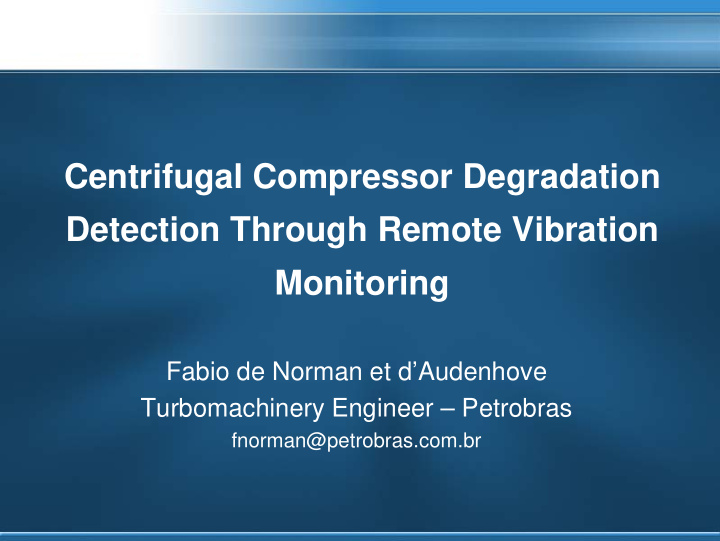



Centrifugal Compressor Degradation Detection Through Remote Vibration Monitoring Fabio de Norman et d’Audenhove Turbomachinery Engineer – Petrobras fnorman@petrobras.com.br
Objective • To present an example of availability gain using vibration remote monitoring systems for early diagnostic.
Compressor Description • Three 2,000,000 SCMD compression trains installed in a 180,000 bpd FPSO (in operation since April 2006). • Three stage compressor trains, consisted of a back- to-back LP and a straight-through HP compressors. • Compression train driven by a single electric motor with VFD for capacity control. • Amine plant, individual for each train, between LP and HP compressors for CO 2 capture. • Degradation in question occurred in a single train (last to enter operation, in February 2007).
Remote Monitoring Description • Remote monitoring today consists of two softwares: – Commercial software specialized in vibration monitoring (higher acquisition rates). – In-house developed, PI based, HMI similar software for process and performance monitoring (lower acquisition rates). • Both softwares available via corporate network to the turbomachinery community: from off-shore operational personal, to on-shore engineering and up to experts concentrated in the technical support and in the turbomachinery workshop.
Remote Monitoring Description Technical On-shore Support Engineering Corporate Network Turbomachinery Off-shore Workshop Operation
Case History • After 6,700 operation hours and 680 start-ups, HP compressor tripped twice due to high vibration in the driven end side, • Trips occurred during loading phase of automatic start-up procedure. • Compressor operator managed to start-up the train in manual control with a slower loading procedure.
Case History • Further investigation of the event by the Technical Support team found an unstable, rapidly increasing, sub-synchronous vibration in the 40-45 Hz range (~0.18X).
Case History • The vibration was diagnosed as an aerodynamic instability. • Due to gas production policy, it was decided to keep the compressor train in monitored operation.
Case History • After 10,200 operation hours and 695 start-ups, the train’s multiplier gearbox failed (not related to presented issue), demanding both the gearbox’s shafts to be replaced and forcing a 14 days down- time. • During the following start-up, the train again tripped due to high vibration during loading. • The event was real-time monitored by the (on-shore) technical support team, who quickly identified the problem.
Case History Start Up 2! . --+ l.lOO"t 13882 13880 13884 13884 13882 13882 13880 13562 13231 12847 12117 1141 5 1141 3 11411 11412 25 Jun 20:30:55.441 11374 25 Jun 20:30:00.077 7210 25 Jun 20:29:08.831 3350 25 Jun 20:27:35.816 0 25 Jun 20:25:05.826 0 25 Jun 20:22:35.837 25 Jun 20:19:55.849 FREQUENCY 50 Hz/div 28 .50 Hz
Case History • Due to unavailability of a second compression train, attempts to start manually the train were made by the operator with technical support’s supervision and orientation (using both vibration and PI-based monitoring). Without success. • Decision to remove and send the HP bundle to the turbomachinery workshop for inspection and further repair.
Case History • When disassembled in the workshop, the cause of the aerodynamic instability was clear: severe loss of material in both inlet and diffuser vanes of the first stage.
Case History • Consulting with technical support’s materials and corrosion experts indicated carbonic acid corrosion. • In shut and cool down, moist in the gas condensed in the cooler suction side, forming, with the CO 2 rich gas, carbonic acid on the suction’s surfaces.
Case History • Repair and substitution of the damaged bundle components took one month in the turbomachinery workshop, after which the bundle returned to the off- shore platform and was reinstalled, being ready for operation. • Total downtime of the compressor train due to the bundle damage was approximately 45 days.
Case History • Without the remote monitoring system, it would have taken at least 7 extra days to diagnose the high vibration, due to required time to mobilize and board specialized equipment (portable vibration acquisition system) and personal and to run monitored tests in the compressor train. • This time is especially long since the necessary resources are scarce, usually been used in other platforms of the basin.
Conclusions • The remote monitoring system shortened the diagnosis of the aerodynamic instability vibration issue in at least 7 days. • Specially worth with critical equipment. In this case, the train’s unavailability represented flaring 1.5x10 6 SCMD. • Still, the losses could have been even more reduced even further if the necessary actions for inspection and eventual repair were taken when the first signs appeared.
Conclusions • This was a learned lesson and our current goal is to use this systems as predictive maintenance tools. • Recently another compressor on the same platform began showing signs of advanced degradation (similar to the presented case, plus increased unbalance) and had it’s bundle replacement for maintenance scheduled before becoming non- operational.
Next Steps • Remote monitoring system been used today almost exclusively to diagnosis. • On-going internal discussions to elaborate and implement procedures for using the system for predictive maintenance. • Most variables and behaviour to be monitored by the on-shore engineering of each platform. • When necessary, technical support would aid in analysing and diagnosing any change in machinery behaviour.
Thank you.
Recommend
More recommend